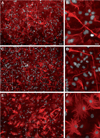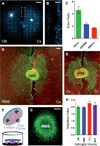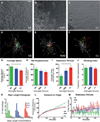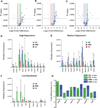Different astroglia permissivity controls the migration of olfactory bulb interneuron precursors
- PMID: 19610095
- PMCID: PMC3817351
- DOI: 10.1002/glia.20918
Different astroglia permissivity controls the migration of olfactory bulb interneuron precursors
Abstract
The rostral migratory stream (RMS) is a well defined migratory pathway for precursors of olfactory bulb (OB) interneurons. Throughout the RMS an intense astroglial matrix surrounds the migratory cells. However, it is not clear to what extent the astroglial matrix participates in migration. Here, we have analyzed the migratory behavior of neuroblasts cultured on monolayers of astrocytes isolated from areas that are permissive (RMS and OB) and nonpermissive (cortex and adjacent cortical areas) to migration. Our results demonstrate robust neuroblast migration when RMS-explants are cultured on OB or RMS-astrocytes, in contrast to their behavior on astroglia derived from nonpermissive areas. These differences, mediated by astrocyte-derived nonsoluble factors, are related to the overexpression of extracellular matrix and cell adhesion molecules, as revealed by real-time qRT-PCR. Our results show that astroglia heterogeneity could play a significant role in migration within the RMS and in cell detachment in the OB.
Figures





Similar articles
-
EphA4 Regulates Neuroblast and Astrocyte Organization in a Neurogenic Niche.J Neurosci. 2017 Mar 22;37(12):3331-3341. doi: 10.1523/JNEUROSCI.3738-16.2017. Epub 2017 Mar 3. J Neurosci. 2017. PMID: 28258169 Free PMC article.
-
Postnatal neurogenesis and gliogenesis in the olfactory bulb from NG2-expressing progenitors of the subventricular zone.J Neurosci. 2004 Nov 17;24(46):10530-41. doi: 10.1523/JNEUROSCI.3572-04.2004. J Neurosci. 2004. PMID: 15548668 Free PMC article.
-
Changes in cell migration and survival in the olfactory bulb of the pcd/pcd mouse.Dev Neurobiol. 2007 Jun;67(7):839-59. doi: 10.1002/dneu.20352. Dev Neurobiol. 2007. PMID: 17506498
-
Extracellular signals controlling neuroblast migration in the postnatal brain.Adv Exp Med Biol. 2014;800:149-80. doi: 10.1007/978-94-007-7687-6_9. Adv Exp Med Biol. 2014. PMID: 24243105 Review.
-
Regulation of subventricular zone-derived cells migration in the adult brain.Adv Exp Med Biol. 2015;853:1-21. doi: 10.1007/978-3-319-16537-0_1. Adv Exp Med Biol. 2015. PMID: 25895704 Review.
Cited by
-
Identification of radial glia-like cells in the adult mouse olfactory bulb.Exp Neurol. 2012 Aug;236(2):283-97. doi: 10.1016/j.expneurol.2012.05.012. Epub 2012 May 23. Exp Neurol. 2012. PMID: 22634209 Free PMC article.
-
Brain-derived neurotrophic factor promotes vasculature-associated migration of neuronal precursors toward the ischemic striatum.PLoS One. 2013;8(1):e55039. doi: 10.1371/journal.pone.0055039. Epub 2013 Jan 29. PLoS One. 2013. PMID: 23383048 Free PMC article.
-
EndoN treatment allows neuroblasts to leave the rostral migratory stream and migrate towards a lesion within the prefrontal cortex of rats.Neural Regen Res. 2020 Sep;15(9):1740-1747. doi: 10.4103/1673-5374.276335. Neural Regen Res. 2020. PMID: 32209781 Free PMC article.
-
An implantable human stem cell-derived tissue-engineered rostral migratory stream for directed neuronal replacement.Commun Biol. 2021 Jul 15;4(1):879. doi: 10.1038/s42003-021-02392-8. Commun Biol. 2021. PMID: 34267315 Free PMC article.
-
New neurons clear the path of astrocytic processes for their rapid migration in the adult brain.Neuron. 2010 Jul 29;67(2):213-23. doi: 10.1016/j.neuron.2010.06.018. Neuron. 2010. PMID: 20670830 Free PMC article.
References
-
- Alves JA, Barone P, Engelender S, Froes MM, Menezes JR. Initial stages of radial glia astrocytic transformation in the early postnatal anterior subventricular zone. J Neurobiol. 2002;52:251–265. - PubMed
-
- Banker G, Goslin K, editors. Culturing nerve cells. Cambridge: MIT Press; 1991. p. 453.
Publication types
MeSH terms
Substances
Grants and funding
LinkOut - more resources
Full Text Sources
Other Literature Sources
Medical
Miscellaneous

